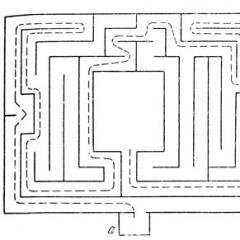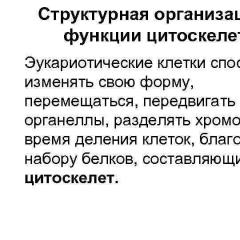Hierarchy of monks. Church ranks in the Orthodox Church. Orders in Orthodoxy
The hierarchy of the Christian church is called the “three-order” because it consists of three main levels:
– diaconate,
- priesthood,
- bishops.
And also, depending on their attitude to marriage and lifestyle, the clergy is divided into “white” - married, and “black” - monastic.
Representatives of the clergy, both “white” and “black,” have their own structures of honorary titles, which are awarded for special services to the church or “for length of service.”
|
Hierarchical what degree |
"Secular clergy |
"Black" clergy |
Appeal |
|
Hierodeacon |
Father deacon, father (name) |
||
|
Protodeacon |
Archdeacon |
Your Excellency, Father (name) |
|
|
Priesthood |
Priest (priest) |
Hieromonk |
Your Reverence, Father (name) |
|
Archpriest |
|||
|
Abbess |
Venerable Mother, Mother (name) |
||
|
Protopresbyter |
Archimandrite |
Your Reverence, Father (name) |
|
|
Bishopric |
Your Eminence, Most Reverend Vladyka, Vladyka (name) |
||
|
Archbishop |
|||
|
Metropolitan |
Your Eminence, Most Reverend Vladyka, Vladyka (name) |
||
|
Patriarch |
Your Holiness, Most Holy Lord |
 Deacon(minister) is called so because the duty of a deacon is to serve at the Sacraments. Initially, the position of deacon consisted of serving at meals, taking care of the maintenance of the poor and sick, and then they served in the celebration of the Sacraments, in the administration of public worship, and in general were assistants to bishops and presbyters in their ministry.
Deacon(minister) is called so because the duty of a deacon is to serve at the Sacraments. Initially, the position of deacon consisted of serving at meals, taking care of the maintenance of the poor and sick, and then they served in the celebration of the Sacraments, in the administration of public worship, and in general were assistants to bishops and presbyters in their ministry.
Protodeacon- chief deacon in a diocese or cathedral. The title is given to deacons after 20 years of service in the priesthood.
Hierodeacon- a monk with the rank of deacon.
Archdeacon- the eldest of the deacons in the monastic clergy, that is, the senior hierodeacon.
 Priest(priest) with the authority of his bishops and on their “instructions” can perform all divine services and Sacraments, except for Ordination (Priesthood - Ordination to the priesthood), the consecration of the World (Incense oil) and the antimension (a quadrangular plate made of silk or linen material with sewn-in particles of relics , where the Liturgy is celebrated).
Priest(priest) with the authority of his bishops and on their “instructions” can perform all divine services and Sacraments, except for Ordination (Priesthood - Ordination to the priesthood), the consecration of the World (Incense oil) and the antimension (a quadrangular plate made of silk or linen material with sewn-in particles of relics , where the Liturgy is celebrated).
Archpriest- senior priest, the title is given for special merits, is the rector of the temple.
Protopresbyter- the highest title, exclusively honorary, given for special church merits on the initiative and decision of His Holiness the Patriarch of Moscow and All Rus'.
Hieromonk- a monk who has the rank of priest.
Abbot- abbot of the monastery, in women's monasteries - abbess.
Archimandrite- monastic rank, given as the highest award to the monastic clergy.  Bishop(guardian, overseer) - not only performs the Sacraments, the Bishop also has the power to teach others through Ordination the grace-filled gift of performing the Sacraments. The bishop is the successor of the apostles, having the grace-filled power to perform all seven sacraments of the Church, receiving in the Sacrament of Ordination the grace of archpastorship - the grace of governing the Church. The episcopal degree of the sacred hierarchy of the church is the highest degree on which all other degrees of the hierarchy (presbyter, deacon) and lower clergy depend. Ordination to the rank of bishop occurs through the Sacrament of the Priesthood. The bishop is elected from the religious clergy and ordained by the bishops.
Bishop(guardian, overseer) - not only performs the Sacraments, the Bishop also has the power to teach others through Ordination the grace-filled gift of performing the Sacraments. The bishop is the successor of the apostles, having the grace-filled power to perform all seven sacraments of the Church, receiving in the Sacrament of Ordination the grace of archpastorship - the grace of governing the Church. The episcopal degree of the sacred hierarchy of the church is the highest degree on which all other degrees of the hierarchy (presbyter, deacon) and lower clergy depend. Ordination to the rank of bishop occurs through the Sacrament of the Priesthood. The bishop is elected from the religious clergy and ordained by the bishops.
An archbishop is a senior bishop who oversees several ecclesiastical regions (dioceses).
Metropolitan is the head of a large ecclesiastical region uniting dioceses (metropolis).
Patriarch (forefather, ancestor) is the highest title of the head of the Christian church in the country.
In addition to the sacred ranks in the church, there are also lower clergy (service positions) - altar servers, subdeacons and readers. They are classified as clergy and are appointed to their positions not through Ordination, but by bishop’s or abbot’s blessing.
 Altar boy- the name given to a male layman who helps the clergy at the altar. The term is not used in canonical and liturgical texts, but became generally accepted in this meaning by the end of the 20th century. in many European dioceses in the Russian Orthodox Church. The name “altar boy” is not generally accepted. In the Siberian dioceses of the Russian Orthodox Church it is not used; instead, a more traditional term is usually used in this meaning sexton, and novice. The sacrament of priesthood is not performed over the altar boy; he only receives a blessing from the rector of the temple to serve at the altar. The responsibilities of the altar server include monitoring the timely and correct lighting of candles, lamps and other lamps in the altar and in front of the iconostasis, preparing the vestments of priests and deacons, bringing prosphora, wine, water, incense to the altar, lighting coal and preparing the censer, giving payment for wiping the lips during Communion, assisting the priest in performing the sacraments and services, cleaning the altar, if necessary, reading during the service and performing the duties of a bell ringer. The altar server is prohibited from touching the throne and its accessories, as well as from moving from one side of the altar to the other between the throne and the Royal Doors. The altar server wears a surplice over lay clothes.
Altar boy- the name given to a male layman who helps the clergy at the altar. The term is not used in canonical and liturgical texts, but became generally accepted in this meaning by the end of the 20th century. in many European dioceses in the Russian Orthodox Church. The name “altar boy” is not generally accepted. In the Siberian dioceses of the Russian Orthodox Church it is not used; instead, a more traditional term is usually used in this meaning sexton, and novice. The sacrament of priesthood is not performed over the altar boy; he only receives a blessing from the rector of the temple to serve at the altar. The responsibilities of the altar server include monitoring the timely and correct lighting of candles, lamps and other lamps in the altar and in front of the iconostasis, preparing the vestments of priests and deacons, bringing prosphora, wine, water, incense to the altar, lighting coal and preparing the censer, giving payment for wiping the lips during Communion, assisting the priest in performing the sacraments and services, cleaning the altar, if necessary, reading during the service and performing the duties of a bell ringer. The altar server is prohibited from touching the throne and its accessories, as well as from moving from one side of the altar to the other between the throne and the Royal Doors. The altar server wears a surplice over lay clothes.
Subdeacon- a clergyman in the Orthodox Church, serving mainly with the bishop during his sacred rites, wearing in front of him in the indicated cases the trikiri, dikiri and ripidas, laying the eagle, washes his hands, vests him and performs some other actions. In the modern Church, a subdeacon does not have a sacred degree, although he wears a surplice and has one of the accessories of the deaconate - an orarion, which he wears crosswise over both shoulders and symbolizes angelic wings. Being the most senior clergyman, the subdeacon is an intermediate link between clergy and clergy. Therefore, the subdeacon, with the blessing of the serving bishop, can touch the throne and the altar during divine services and at certain moments enter the altar through the Royal Doors.
Reader- in Christianity - the lowest rank of clergy, not elevated to the degree of priesthood, reading the texts of the Holy Scriptures and prayers during public worship. In addition, according to ancient tradition, readers not only read in Christian churches, but also interpreted the meaning of difficult-to-understand texts, translated them into the languages of their area, delivered sermons, taught converts and children, sang various hymns (chants), engaged in charity work, had other church obediences. In the Orthodox Church, readers are ordained by bishops through a special rite - hirothesia, otherwise called “ordaining”. This is the first initiation of a layman, only after which can he be ordained as a subdeacon, and then ordained as a deacon, then as a priest and, higher, as a bishop (bishop). The reader has the right to wear a cassock, belt and skufia. During tonsure, a small veil is first put on him, which is then removed and a surplice is put on.  Monasticism has its own internal hierarchy, consisting of three degrees (belonging to them usually does not depend on belonging to one or another hierarchical degree itself): monasticism(Rassophore), monasticism(small schema, small angelic image) and schema(great schema, great angelic image). The majority of modern monastics belong to the second degree - to monasticism proper, or the small schema. Only those monastics who have this particular degree can receive Ordination to the rank of bishop. To the name of the rank of monastics who have accepted the great schema, the particle “schema” is added (for example, “schema-abbot” or “schema-metropolitan”). Belonging to one degree or another of monasticism implies a difference in the level of strictness of monastic life and is expressed through differences in monastic clothing. During monastic tonsure, three main vows are made - celibacy, obedience and non-covetousness (the promise to endure all sorrow and hardship of monastic life), and a new name is assigned as a sign of the beginning of a new life.
Monasticism has its own internal hierarchy, consisting of three degrees (belonging to them usually does not depend on belonging to one or another hierarchical degree itself): monasticism(Rassophore), monasticism(small schema, small angelic image) and schema(great schema, great angelic image). The majority of modern monastics belong to the second degree - to monasticism proper, or the small schema. Only those monastics who have this particular degree can receive Ordination to the rank of bishop. To the name of the rank of monastics who have accepted the great schema, the particle “schema” is added (for example, “schema-abbot” or “schema-metropolitan”). Belonging to one degree or another of monasticism implies a difference in the level of strictness of monastic life and is expressed through differences in monastic clothing. During monastic tonsure, three main vows are made - celibacy, obedience and non-covetousness (the promise to endure all sorrow and hardship of monastic life), and a new name is assigned as a sign of the beginning of a new life.
In order to get a more detailed understanding of who conducts services in the church or who speaks on television from the Russian Orthodox Church, it is necessary to know exactly what ranks there are in the Church and the Monastery, as well as their hierarchy. We recommend that you read
In the Orthodox world, Church ranks are divided into ranks of white clergy (Rites of the Church) and ranks of black clergy (Monastic ranks).
CHURCH OFFICERS OR WHITE CLERGY
CHURCH OFFICES – ALTARNIKIn the worldly understanding, recently the Church rank of Altarnik has begun to disappear, and instead of it the rank of Sexton or Novice is increasingly mentioned. The tasks of the Altarman include the duties of carrying out the instructions of the rector of the temple; as a rule, such duties include maintaining a candle fire in the temple, lighting lamps and other lighting devices in the altar and iconostasis, they also help the priests put on clothes, bring prosphora, incense to the temple and perform other menial work. The altar boy can be recognized by the fact that he wears a surplice over his secular clothes. We recommend that you familiarize yourself with
|
|
This is the lowest rank of the church and the reader is not included in the priesthood. The reader's duties include reading sacred texts and prayers during worship. In case of advancement in rank, the reader is ordained subdeacon. CHURCH OFFICES – HYPODIACON
It is something of an intermediate rank between the laity and the clergy. Unlike the readers and altar servers, the subdeacon is allowed to touch the throne and the altar, as well as enter the altar through the royal gate, although the subdeacon is not a clergyman. The duties of this Church rank include assisting the Bishop in Divine services. We recommend that you read CHURCH OFFICES – DEACON
The lowest level of clergy, as a rule, the duties of deacons include helping priests in worship, although they themselves do not have the right to perform public worship and be representatives of the church. Since a priest has the opportunity to perform rituals without a deacon, the number of deacons is currently being reduced, as the need for them is no longer needed. CHURCH OFFICES – PROTODEACON OR PROTODEACON
This rank indicates the chief deacon in cathedrals; as a rule, such a rank is assigned to a deacon after at least 15 years of service and is a special reward for service.

Currently, this rank is held by priests, and is designated as a junior title of priest. Priests, receiving power from bishops, have the right to conduct church ceremonies, teach people the Orthodox faith and perform other sacraments, but at the same time priests are prohibited from conducting ordination as priests. CHURCH OFFICERS – ARCHOPRISH
Practically the same as the priest, with the only exception that the archpriest is, as it were, senior over the priests and is usually the rector of the temple. We recommend that you read CHURCH OFFICES – PROTOPRESTER
The highest Church rank in the white clergy is not, as it were, a separate rank and is awarded only as a reward for the most deserved deeds before the Orthodox faith and is appointed only by the Patriarch of Moscow and All Rus'.
Monastic orders or black clergy
CHURCH OFFICES – HIERODEACON: He is a monk with the rank of deacon.CHURCH OFFICES – ARCHIDEACON: He is a senior hierodeacon.
CHURCH OFFICES – HIEROMONCH: He is a monastic priest with the right to perform Orthodox sacraments.
CHURCH OFFICES – IGUMENE: He is the abbot of an Orthodox monastery.
CHURCH OFFICES – ARCHIMADRID: The highest degree in the monastic ranks, but occupying a step lower than bishop.
CHURCH OFFICES – BISHOP: This rank is supervisory and has the third degree of priesthood and can also be called a bishop.
CHURCH OFFICES – METROPOLITAN: The highest title of bishop in the church.
CHURCH OFFICES – PATRIARCH: The most senior rank of the Orthodox Church.







